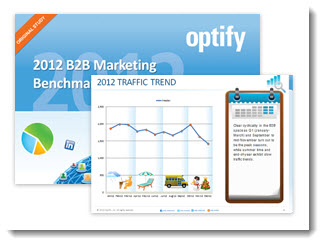You see a lot of so-called “benchmark reports” in B2B marketing circles, and most of them are, well: complete rubbish. The reason many of these reports are worthless, in my view, is that they’re based on non-randomized surveys, and thus the results are influenced heavily by who chooses to respond. This is what statisticians refer to as “self-selection bias” – essentially, that people who choose to respond to surveys may be different from those who do not respond.
The metrics reported by B2B benchmark reports can also be grossly misleading. Most surveys on the topic of B2B email marketing, for example, lump multiple offer types (Webinars, white papers, demos, free trials) into the same single reporting bucket, which renders the cumulative data meaningless. Also, my personal observation is that reported benchmarks for basic email metrics like open rates, click rates, and conversion rates are usually far higher than the norm. I believe this is because people more likely to complete this type of survey are those who feel positive about their own metrics. This bias leads to an inevitable over-inflation of the mean results. (It could also be because the metrics that survey-takers report are simply guesstimates, and therefore inaccurate.)
 All of this is one reason why I find the “2012 B2B Marketing Benchmark Report,” recently published by Optify, so credible and useful. Optify’s suite of digital marketing software is Web-based, so they’re able to extract metrics directly from their clients’ Web activity without any selection bias, excepting any prejudice due to the type of organization with whom they do business. (Optify’s customers are primarily small- to mid-size companies.)
All of this is one reason why I find the “2012 B2B Marketing Benchmark Report,” recently published by Optify, so credible and useful. Optify’s suite of digital marketing software is Web-based, so they’re able to extract metrics directly from their clients’ Web activity without any selection bias, excepting any prejudice due to the type of organization with whom they do business. (Optify’s customers are primarily small- to mid-size companies.)
The data contained in the report were extracted by analyzing more than 62 million Website visits, 215 million page views, and 350,000 leads from more than 600 Optify customers. Alas, email metrics are NOT included in the report (Optify is better known for SEO and Website analytics) but the results make for some illuminating reading nonetheless. Some of the key findings that I found most useful include:
* Web traffic is seasonal. B2B companies reported much higher traffic in the first quarter and from September to mid-November. Should this impact on when B2B marketers plan their demand generation campaigns – perhaps focusing on Q1 and late Q3/early Q4?
* More than 10 percent of the reporting companies discontinued their paid search (SEM) campaigns in 2012. Is this because paid search is becoming ineffective as a lead generation vehicle, or is it (as I suspect) because so many companies attempt paid search without a full understanding of basic SEM best practices? Or is it simply because many companies feel they “should” be doing paid search when maybe it’s just not a fit for their business or sales model?
* Twitter is by far the most effective social media channel for generating leads, outperforming Facebook and LinkedIn by a factor of 9 to 1, even though Facebook generates the larger percentage of visits (from social media sources), and LinkedIn shows the highest engagement rates (page views per visit.) This mirrors what our agency is seeing with the growing success of channels like Promoted Tweets.
Optify added email marketing to their solution suite mid-year in 2012, so I’ll be interested to see next year’s report and will be hoping that it contains useful data on email metrics, particularly if segmented by offer type. In the meantime, this year’s edition is a worthy read for any B2B marketer looking to benchmark their own demand generation, social media, and Website performance.
To download a copy of Optify’s report (free of charge, registration required), click here.
